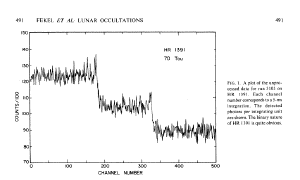Post
The Reveal
12 August 2013
 F. C. Fekel, et al
F. C. Fekel, et alAn occultation is where one object passes in front of another from your vantage point. It is similar to an eclipse or transit, but in this case the occulting object completely blocks the more distant object. Typically occultations occur when the moon occults planets, or when solar system objects occult stars.
Usually occultations hit the news when the moon occults a planet or particularly bright star, which are fairly rare. But lunar occultations of faint stars occurs all the time, and it can be a useful tool for astronomers.
The Moon has two properties that are particularly useful during occultations. The first is that it has a large apparent size (about half a degree of arc), so it can occult a fairly wide strip of the sky. The second is that it has no atmosphere. This means that as the Moon passes in front of a planet or star, there is no atmospheric distortion. The Moon acts as a hard edge that sweeps across the object to block it.
This means we can observe a star as it is gradually blocked or revealed by the Moon to get slice by slice data. By analyzing this data we can gain information about the star. For example, recently lunar occultations of faint stars were analyzed to discover 25 new binary stars.1
These new binary stars are too close together to easily resolve as separate stars, and using the spectroscopic method to distinguish them as binaries would require long term observations. But a lunar occultation can reveal their binary nature. You can see how this was done in the figure above. The brightness of a star is measured as the Moon begins to pass in front of it. As you can see, the brightness level drops in two steps. The first drop occurs as one star of the binary is occulted by the Moon, and the second drop occurs when the other star is occulted. If it were a single star, there would be only a single drop as the star is blocked.
By observing faint stars occulted by the moon, the team was able to identify the ones with a two-step change in brightness, thus revealing them as binary stars. Further analysis of the brightness levels can tell us about the relative brightness of each star, which helps us determine the size of each star in the binary pair.
Sometimes a chance celestial alignment can reveal more about our stellar neighborhood.
Richichi, A., et al. “Twenty-five subarcsecond binaries discovered by lunar occultations.” The Astronomical Journal 146.3 (2013): 59. ↩︎